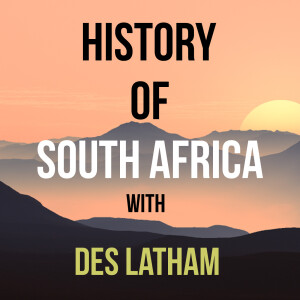
History of South Africa podcast
History

Episode 48 – Petrus Pienaar shot dead on his Hantam farm in 1797 and the Afrikaaner rebellion goes into top gear
 2022-01-09
2022-01-09
Download
Right click and do "save link as"
This is episode 48 and we’re following the sagas of the Visagies and others in the Hantam, that rough and ready part of the northern Cape.
This chaotic land had spawned another by the name of Petrus Pienaar of the Afrikaaners. Regarded as one of the most influential men of the frontier, Pienaar emerged as the spokesman of the Hantammers.
He was closely linked to the Afrikaaner Oorlams from at least the 1780s and was capable of incredible feats of physical endurance even by the standards of the day.
In 1790 he wrote a letter to the Landdrost of Stellenbosch outlining the crisis in the Hantam and suggesting solutions. Some of these would be what we now call .. a final solution particularly when it came to the San.
He wanted more firearms and ammunition delivered to the local
Interestingly, Pienaar wanted the mixed people – those who were known as the Bastaards and as he said “both baptised and unbaptised” – to be supplied with firearms along with the farmers.
Meanwhile the authorities in the Cape launched what would eventually become a settler tradition in South Africa – the passbook system. It meant carrying a pass, or Inboek as it was known in the 1790s, where Khoesan and Bastaards entering the Cape had to carry this document, and were prohibited buying arms from the trekboers.
Ironically, Klaas Afrikaaner was soon registered as a Hottentot Corps as a Khoikhoi chief in 1793. This will come as a surprise of struggle political experts, who view Klaas as a kind of forerunner of the ANC and SWAPO in Namibia. He actually was a collaborationist – along with his followers which will disappoint fundamentalists across the race divide.
SWAPO saw Klaas Afrikaaner as a proto-Namibian nationalist, resisting white power, but it was his descendants who would be synonymous as colonial resisters in the 19th and 20th Century.
Right now they were collaborators - but not for long.
view more
This chaotic land had spawned another by the name of Petrus Pienaar of the Afrikaaners. Regarded as one of the most influential men of the frontier, Pienaar emerged as the spokesman of the Hantammers.
He was closely linked to the Afrikaaner Oorlams from at least the 1780s and was capable of incredible feats of physical endurance even by the standards of the day.
In 1790 he wrote a letter to the Landdrost of Stellenbosch outlining the crisis in the Hantam and suggesting solutions. Some of these would be what we now call .. a final solution particularly when it came to the San.
He wanted more firearms and ammunition delivered to the local
Interestingly, Pienaar wanted the mixed people – those who were known as the Bastaards and as he said “both baptised and unbaptised” – to be supplied with firearms along with the farmers.
Meanwhile the authorities in the Cape launched what would eventually become a settler tradition in South Africa – the passbook system. It meant carrying a pass, or Inboek as it was known in the 1790s, where Khoesan and Bastaards entering the Cape had to carry this document, and were prohibited buying arms from the trekboers.
Ironically, Klaas Afrikaaner was soon registered as a Hottentot Corps as a Khoikhoi chief in 1793. This will come as a surprise of struggle political experts, who view Klaas as a kind of forerunner of the ANC and SWAPO in Namibia. He actually was a collaborationist – along with his followers which will disappoint fundamentalists across the race divide.
SWAPO saw Klaas Afrikaaner as a proto-Namibian nationalist, resisting white power, but it was his descendants who would be synonymous as colonial resisters in the 19th and 20th Century.
Right now they were collaborators - but not for long.
More Episodes
012345678910111213141516171819
Create your
podcast in
minutes
- Full-featured podcast site
- Unlimited storage and bandwidth
- Comprehensive podcast stats
- Distribute to Apple Podcasts, Spotify, and more
- Make money with your podcast
It is Free
- Privacy Policy
- Cookie Policy
- Terms of Use
- Consent Preferences
- Copyright © 2015-2024 Podbean.com





